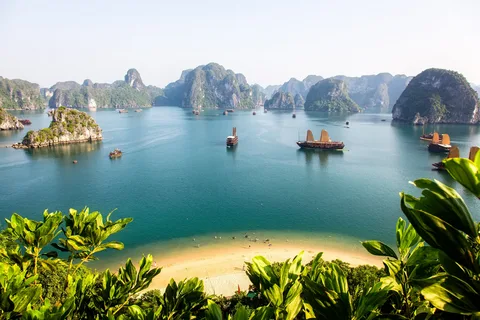Vietnam
Vietnam
Vietnam is a stunningly diverse country in Southeast Asia, known for its breathtaking landscapes, rich history, and vibrant culture. From the bustling streets of Hanoi and Ho Chi Minh City (Saigon) to the serene beauty of Ha Long Bay, Vietnam offers a unique blend of ancient traditions, colonial history, and natural wonders. Whether you’re an adventurer, a history buff, a foodie, or someone seeking relaxation, Vietnam has something to offer everyone.
Key Attractions and Things to Do in Vietnam:
1. Hạ Long Bay
Hạ Long Bay is one of Vietnam’s most iconic destinations, known for its emerald waters and thousands of limestone islands topped with rainforests. You can take a boat cruise around the bay, go kayaking, or explore the caves and grottoes that dot the islands.
Best for: Scenic cruises, photography, and nature lovers.
2. Hanoi
The capital city of Vietnam, Hanoi, is a vibrant mix of French colonial architecture, ancient temples, and bustling streets. The Old Quarter is known for its narrow streets, street food stalls, and local markets. The Hoan Kiem Lake and the Temple of Literature are must-see spots in the city.
Best for: History, culture, food, and sightseeing.
3. Hue
Hue, the former capital of Vietnam, is home to historic imperial architecture, including the Imperial City, Hue Citadel, and the Tomb of Emperor Tu Duc. The city’s rich cultural heritage, ancient temples, and tranquil river make it a peaceful place to explore.
Best for: History lovers, cultural exploration, and temple visits.
4. Hoi An
Hoi An is a charming town known for its preserved Ancient Town, a UNESCO World Heritage site. The town is famous for its lantern-lit streets, ancient houses, vibrant markets, and delicious local cuisine, including cao lau (a noodle dish). Hoi An is also known for its tailor shops where you can get custom-made clothes.
Best for: Photography, cultural exploration, and shopping.
5. Phong Nha-Kẻ Bàng National Park
This UNESCO World Heritage site is home to the stunning Son Doong Cave, the largest cave in the world, as well as other incredible caves and karst landscapes. Phong Nha is perfect for adventure lovers, offering opportunities for cave exploration, hiking, and river tours.
Best for: Caving, hiking, and nature adventures.
6. Ho Chi Minh City (Saigon)
Ho Chi Minh City, formerly known as Saigon, is a bustling metropolis that offers a mix of modern skyscrapers, historical landmarks, and vibrant street life. Must-see attractions include the War Remnants Museum, Notre-Dame Cathedral, Ben Thanh Market, and the Cu Chi Tunnels, which provide insight into the country’s history during the Vietnam War.
Best for: History, culture, shopping, and vibrant city life.
7. Mekong Delta
The Mekong Delta, known as the “Rice Bowl of Vietnam,” is a network of rivers, swamps, and islands in the southern part of the country. Visitors can explore the delta by boat, visiting floating markets, traditional villages, and lush rice paddies. The Cai Be Floating Market is a must-visit for an authentic experience.
Best for: River cruises, cultural immersion, and nature.
8. Sapa
Sapa, located in the northern part of Vietnam, is a mountainous region known for its stunning terraced rice fields, traditional hill tribes, and vibrant markets. The area offers some of the best trekking in Vietnam, including treks to Fansipan, the highest peak in Vietnam.
Best for: Trekking, cultural experiences, and nature lovers.
9. Nha Trang
Nha Trang is a coastal city known for its beautiful beaches, vibrant nightlife, and luxury resorts. It’s perfect for those looking to relax by the sea, go scuba diving or snorkeling, and visit attractions like the Po Nagar Cham Towers and the Long Son Pagoda.
Best for: Beach lovers, water sports, and relaxation.
10. Cu Chi Tunnels
The Cu Chi Tunnels are an extensive network of underground tunnels used by the Viet Cong during the Vietnam War. The tunnels offer a fascinating look at wartime life and strategy, and visitors can explore the network and learn about the techniques used by the soldiers.
Best for: History and war enthusiasts.
11. Ba Na Hills
Located in the Da Nang region, Ba Na Hills is a mountain resort that offers a range of activities. The Golden Bridge, supported by giant hands, is a popular attraction here. You can also explore the Ba Na Cable Car, which holds the world record for the longest non-stop cable car at over 5,800 meters.
Best for: Scenic views, cable car rides, and unique photo opportunities.
12. Cat Ba Island
Cat Ba Island is part of the Cat Ba Archipelago in the north of Vietnam, and it’s an excellent destination for those seeking outdoor adventure. The island is known for its pristine beaches, hiking trails, and the Cat Ba National Park, which is home to diverse wildlife.
Best for: Hiking, nature exploration, and beach activities.
Best Time to Visit Vietnam:
November to April: The best time to visit Vietnam is during the dry season when the weather is pleasant, particularly in the central and southern regions. Northern Vietnam (Hanoi, Sapa) can get cold during the winter months.
May to October: This is the monsoon season in Vietnam, with frequent rainfall, especially in the central and southern regions. While it’s less ideal for beach activities and outdoor adventures, it can still be a good time to visit northern regions like Hanoi and Sapa, which are cooler during this time.
Conclusion:
Vietnam is a country that offers a diverse range of experiences, from its rich cultural heritage and historical landmarks to its beautiful natural landscapes and thriving modern cities. Whether you want to explore ancient temples, trek through lush mountains, relax on pristine beaches, or immerse yourself in vibrant street food culture, Vietnam has it all. With its friendly locals, affordable travel options, and rich traditions, it’s a destination that promises to captivate and inspire travelers.

